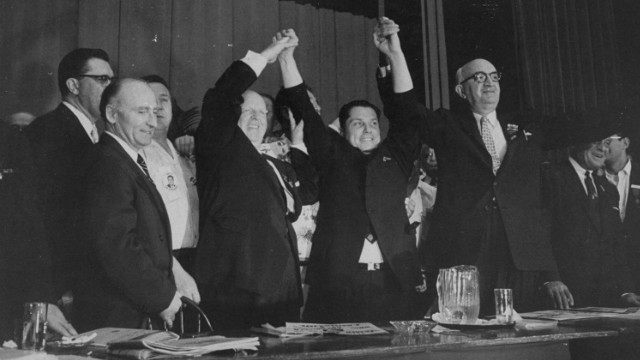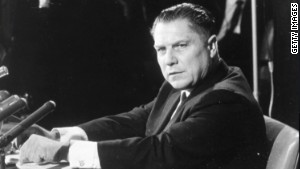- Back to Home »
- 'Highly credible' info prompts dig
 Nearly 40 years after his disappearance, former Teamsters boss Jimmy Hoffa, pictured circa 1955, remains among America's most famous missing persons. Authorities have been searching for the once powerful union boss since he vanished in 1975.
Nearly 40 years after his disappearance, former Teamsters boss Jimmy Hoffa, pictured circa 1955, remains among America's most famous missing persons. Authorities have been searching for the once powerful union boss since he vanished in 1975.  Hoffa slumps in a chair at the Teamsters union office. He was one of the most powerful union leaders in America until being forced out of the organized labor movement. He went to prison in 1967 for jury tampering and fraud before being pardoned four years later.
Hoffa slumps in a chair at the Teamsters union office. He was one of the most powerful union leaders in America until being forced out of the organized labor movement. He went to prison in 1967 for jury tampering and fraud before being pardoned four years later.  Hoffa appears at the Teamsters union convention in 1957, the year he first became union president.
Hoffa appears at the Teamsters union convention in 1957, the year he first became union president.  Hoffa, center, stands with other officials at the Teamsters convention, where he made a successful bid for control of the union in 1957.
Hoffa, center, stands with other officials at the Teamsters convention, where he made a successful bid for control of the union in 1957.  Hoffa testifies at a Senate Rackets Committee hearing in 1958.
Hoffa testifies at a Senate Rackets Committee hearing in 1958.  Hoffa on the phone at an airport in 1959.
Hoffa on the phone at an airport in 1959.  An office for Teamsters union local chapters that Hoffa set up.
An office for Teamsters union local chapters that Hoffa set up.  Hoffa eats with union leader Joseph Curran, left, in 1959.
Hoffa eats with union leader Joseph Curran, left, in 1959.  Hoffa holds a Teamsters rally at Madison Square Garden in New York in 1960.
Hoffa holds a Teamsters rally at Madison Square Garden in New York in 1960.  Hoffa leads supporters at a Teamsters convention in 1959.
Hoffa leads supporters at a Teamsters convention in 1959.  The Teamsters boss appears on the cover of Life magazine on May 18, 1959. The headline reads, "A National Threat: Hoffa's Teamsters; Part 1: Sources of a Union's Uncurbed Power."
The Teamsters boss appears on the cover of Life magazine on May 18, 1959. The headline reads, "A National Threat: Hoffa's Teamsters; Part 1: Sources of a Union's Uncurbed Power."  Hoffa, pictured circa 1960, was a powerful labor leader at a time when unions wielded a great deal of sway over elections and were notoriously tied to organized crime.
Hoffa, pictured circa 1960, was a powerful labor leader at a time when unions wielded a great deal of sway over elections and were notoriously tied to organized crime.  From left, "Meet the Press" moderator Ned Brooks, Lawrence K. Spivak and Hoffa appear at an NBC studio.
From left, "Meet the Press" moderator Ned Brooks, Lawrence K. Spivak and Hoffa appear at an NBC studio.  Hoffa and his son, James Phillip, enter a federal courtroom in July 1964. His son is the current president of the Teamsters.
Hoffa and his son, James Phillip, enter a federal courtroom in July 1964. His son is the current president of the Teamsters.  Hoffa, second row, center, leaves court after being found guilty of jury tampering in 1964.
Hoffa, second row, center, leaves court after being found guilty of jury tampering in 1964.  Hoffa at the Pittsburgh airport in 1971 on his way back to federal prison after being let out to visit his ailing wife. He was released from prison later that year on the condition he not resume union activity before 1980.
Hoffa at the Pittsburgh airport in 1971 on his way back to federal prison after being let out to visit his ailing wife. He was released from prison later that year on the condition he not resume union activity before 1980.  Hoffa poses for a picture on July 24, 1975, less than a week before his disappearance. He was 62 at the time.
Hoffa poses for a picture on July 24, 1975, less than a week before his disappearance. He was 62 at the time.  A Bloomfield Township, Michigan, police officer stands beside Hoffa's car after the former labor leader's disappearance in July 1975. Hoffa was last seen at a restaurant in suburban Detroit on July 30, 1975.
A Bloomfield Township, Michigan, police officer stands beside Hoffa's car after the former labor leader's disappearance in July 1975. Hoffa was last seen at a restaurant in suburban Detroit on July 30, 1975.  Police sweep a field in Waterford Township, Michigan, in search of Hoffa's body in July 1975.
Police sweep a field in Waterford Township, Michigan, in search of Hoffa's body in July 1975.  Demolition workers in 2006 tear down a horse barn for the FBI in a search for Hoffa's remains in Milford, Michigan. The FBI had received a tip that Hoffa was buried on the farm.
Demolition workers in 2006 tear down a horse barn for the FBI in a search for Hoffa's remains in Milford, Michigan. The FBI had received a tip that Hoffa was buried on the farm. 
1

2

3

4

5

6

7

8

9

10

11

12

13

14

15

16

17

18

19

20
- FBI agent says information "reached the threshold of probable cause"
- The search is based in part in information provided by an alleged mobster
- The FBI has spent months looking into Tony Zerilli's claims
- Hoffa, then 62, was last seen on July 30, 1975, outside a Detroit-area restaurant
Oakland Township, Michigan (CNN) -- The FBI -- working on information from an aging reputed mobster -- will continue digging in the waist-high grass of a Detroit-area field Tuesday in yet another search for the remains of former Teamsters boss Jimmy Hoffa.
The information that sparked the latest hunt in the nearly four-decades-long search for Hoffa is "highly credible," a source familiar with the investigation said.
Agents were executing a search warrant for a field in Oakland Township, north of Detroit, based in part on information provided by alleged mobster Tony Zerilli.
The paperwork filed under seal that accompanies the search warrant is described as "several pages long," according to the source, and it explains thy the FBI believes the search is justified.
 FBI digs for Jimmy Hoffa's remains
FBI digs for Jimmy Hoffa's remains  Police: Hoffa a wound that won't go away
Police: Hoffa a wound that won't go away  January: Hoffa burial site revealed?
January: Hoffa burial site revealed?  2012: New hunt for Hoffa's remains
2012: New hunt for Hoffa's remains "The information provided by Tony Zerilli is highly credible," the source said.
By late afternoon, the search had been underway for several hours but there were no indications of any developments.
The search was on private property, and media and curious onlookers were kept some distance from the search site.
FBI Special Agent Bob Foley, head of the agency's Detroit office, told CNN at the scene that the information leading to the search "reached the threshold of probable cause, which was sufficient to allow us to obtain a search warrant.
"If it didn't rise to that level then, certainly, we wouldn't be out here."
Earlier this year, Zerilli, now in his 80s, told New York's NBC 4 that Hoffa was buried in a Michigan field about 20 miles north of where he was last seen in 1975.
The FBI has spent months looking into Zerilli's claims before seeking court authorization to excavate the field and look for evidence of a shallow grave, according to the source.
Contrary to what's been previously thought for years, Zerilli said he was told Hoffa's disappearance was not connected to Genovese family New Jersey crime boss Anthony "Tony" Provensano who allegedly wanted to get rid of Hoffa.
Instead, according to the source, Zerilli told the FBI Detroit mobsters wanted Hoffa dead.
At the time, Hoffa was thought to be setting the stage to get back into a power position with the labor movement after he was released from prison. He was convicted in 1967 for jury tampering and fraud. President Richard Nixon pardoned him in 1971.
Hoffa, then 62, was last seen on July 30, 1975, outside a Detroit-area restaurant. The FBI said at the time that the disappearance could have been linked to Hoffa's efforts to regain power in the Teamsters and to the mob's influence over the union's pension funds.
Zerilli was in prison himself when Hoffa disappeared.
Zerilli, according to the source, said he when he was freed, he asked a mob enforcer what happened to Hoffa.
The mobster allegedly told Zerilli tht Detroit's crime bosses ordered the Hoffa hit. They lured him to a meeting, then drove him to a farm owned by a mob underboss. The enforcer allegedly told Zerilli that Hoffa was killed and buried on the property, which covers several acres.
The area being searched Monday was described as relatively small -- about the size of a small party tent, according to the source.
Hoffa's disappearance and presumed death have vexed investigators in the years since his last sighting. As recently as October, soil samples were taken from a home in the suburban Detroit community after a tipster claimed he saw a body buried in the yard a day after Hoffa disappeared.
The soil samples were tested, and showed no evidence of human remains or decomposition.
Zerilli, freed in 2008 after his last prison sentence, was convicted of crimes in connection with organized crime in Detroit. Keith Corbett, a former U.S. attorney, told CNN earlier this year that Zerilli headed a Detroit organized crime family from 1970 to 1975, but was in fact in prison when Hoffa disappeared.
In an interview with CNN affiliate WDIV-TV, Zerilli denied playing any role in Hoffa's disappearance.
Man convicted in mob crimes says he's 'certain' where Hoffa is buried
CNN's Laura Batchelor contributed to this report.







